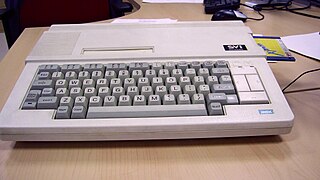
MSX is a standardized home computer architecture, announced by ASCII Corporation on June 16, 1983. It was initially conceived by Microsoft as a product for the Eastern sector, and jointly marketed by Kazuhiko Nishi, the director at ASCII Corporation. Microsoft and Nishi conceived the project as an attempt to create unified standards among various home computing system manufacturers of the period, in the same fashion as the VHS standard for home video tape machines. The first MSX computer sold to the public was a Mitsubishi ML-8000, released on October 21, 1983, thus marking its official release date.
MSX BASIC is a dialect of the BASIC programming language. It is an extended version of Microsoft's MBASIC Version 4.5, adding support for graphic, music, and various peripherals attached to MSX microcomputers. Generally, MSX BASIC is designed to follow GW-BASIC, released the same year for IBM PCs and clones. During the creation of MSX BASIC, effort was made to make the system flexible and expandable.

The Tatung Einstein is an eight-bit home/personal computer produced by Taiwanese corporation Tatung, designed in Bradford, England at Tatung's research laboratories and assembled in Bridgnorth and Telford, England. It was aimed primarily at small businesses.

The Yamaha V9958 is a Video Display Processor used in the MSX2+ and MSX turbo R series of home computers, as the successor to the Yamaha V9938 used in the MSX2. The main new features are three graphical YJK modes with up to 19268 colors and horizontal scrolling registers. The V9958 was not as widely adopted as the V9938.

The Yamaha V9938 is a video display processor (VDP) used on the MSX2 home computer, as well as on the Geneve 9640 enhanced TI-99/4A clone and the Tatung Einstein 256. It was also used in a few MSX1 computers, in a configuration with 16kB VRAM.

The SV-328 is an 8-bit home computer introduced by Spectravideo in June 1983. It was the business-targeted model of the Spectravideo range, sporting a compact full-travel keyboard with numeric keypad. It had 80 KB RAM, a respectable amount for its time. Other than the keyboard and RAM, this machine was identical to its little brother, the SV-318.

The SVI-728 is the first home computer from Spectravideo that complied fully with the MSX home computer specification. It was introduced in 1984. The design is virtually identical to that of the earlier SV-328, which did not comply fully with the MSX standard.

The Spectravideo SVI-738 X'Press is an MSX1 compatible home computer manufactured by Spectravideo from 1985. Although compatible with the MSX 1.0 standard, it incorporates several extensions to the standard ; many are hardware-compatible with the MSX 2.0 standard but the system as a whole is not, leading to it being referred to as an "MSX 1.5" computer.

The VG-8020 was Philips' third MSX computer introduced in 1984, after the VG-8000 and the VG-8010 computers.

Philips NMS 8250, was a professional MSX2 home computer for the high end market, with a built in floppy disk drive in a "pizza box" configuration, released in 1986. The machine was in fact manufactured by Sanyo and it is basically the MPC-25FS with a different color.
An MSX-ENGINE chip is a specially developed integrated circuit for home computers that are built according to the MSX specifications. Generally, such a chip combines the functions of many separate, older/simpler chips into one. This is done to reduce required circuit board space, power consumption, and production costs for complete systems.

The Panasonic FS-A1WSX released in 1989 was the last MSX2+ made by Panasonic. It was the successor of FS-A1WX and incorporated few changes like S-Video output, no tape support, color printer support and an improved A1 Internal Cockpit software with a Kanji color word processor.
The HB-F9P was a Sony MSX2-computer, launched in 1985. The abbreviation HB stands for Hit Bit.
The TC 3256 or Timex Computer 3256 was a 1987 computer created by Timex of Portugal, a branch of Timex Corporation.

The Philips VG-8000, released in 1983, was the first Philips MSX computer, although it was not 100% compliant with the standard.

The TK 3000 IIe is a personal microcomputer model manufactured by the Brazilian company Microdigital Eletrônica Ltda., compatible with the Apple IIe Enhanced. It was presented to the public at the V International Computing Fair in September 1985, and entered the market in April 1986 with a retail price of Cz$ 12,500.00. In 1987 an updated version, the TK 3000 IIe COMPACT was released.
The Philips NMS 8220 is a personal computer released in 1986 and compatible with the MSX2 standard. Developed by the Dutch electronics company Philips, it was aimed at both home users and small businesses. The NMS 8220 was one of the many computers that adhered to the MSX standard, a popular home computing platform in the 1980s that sought to unify hardware specifications across various manufacturers, enabling software compatibility.
The Philips NMS 8245 is a personal computer released by Philips in 1987 as part of its MSX2 line of computers.
The Philips VG-8230 is a MSX2 standard compatible personal computer released in 1986. It was the first MSX2 machine from Philips, aimed at home users with a focus on both gaming and productivity.

The Philips VG-8235 is a Philips MSX2 compatible home computer, released in 1986 in Europe. It was developed and manufactured by the NEC.














